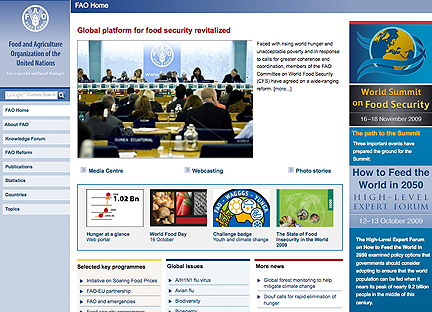Meanwhile, the FAO is also part of the GEO partnership building the nexgen monitoring service for forest nations that will increase the current five-yearly evaluation of global forest cover to annual assessments, including carbon measures. GEO, or Group on Earth Observations, includes 80 governments along with NASA, the European Space Agency and their counterparts in Japan, Germany, Italy, India and Brazil, all aiming to pool their technology and Earth coverage to build a new coordinated global forest monitoring system. The new system will not just offer users an accurate picture of forest cover, but also a measurement of the carbon stocks within, under a variety of methodologies. This will further underpin REDD, providing support to national policymakers, the UNFCCC and emerging carbon markets. The governments of Australia, Canada, Japan and Norway are driving the development of the new system, which is to undergo a trial demonstration phase until the end of 2010 in Australia, Brazil, Cameroon, Guyana, Indonesia, Mexico, Tanzania and possibly Colombia and Peru.
Satnews Daily
October 21st, 2009
Free Satellite Imagery To Battle Deforestation Across The Globe
The UN food agency has announced it will make available satellite imaging free to developing countries to underpin avoided deforestation efforts, while a partnership of governments and space agencies announces a new system to produce comprehensive annual assessments of global forest changes.
 The Food and Agriculture Organisation (FAO), together with the State University of South Dakota, US Geological Survey and EU Joint Research Center, will make available an existing database of accessible, high-resolution satellite data to forest nations. The system can offer data for 13,000 locations worldwide as well as access to tools the FAO says will make it easy for governments to get a handle on the status of their forests. An emerging REDD (Reduced Emissions from Deforestation and Degradation) mechanism being negotiated at the UN is struggling to overcome many challenges, including how to credibly measure, report and verify forest carbon emissions across many developing nations.
The Food and Agriculture Organisation (FAO), together with the State University of South Dakota, US Geological Survey and EU Joint Research Center, will make available an existing database of accessible, high-resolution satellite data to forest nations. The system can offer data for 13,000 locations worldwide as well as access to tools the FAO says will make it easy for governments to get a handle on the status of their forests. An emerging REDD (Reduced Emissions from Deforestation and Degradation) mechanism being negotiated at the UN is struggling to overcome many challenges, including how to credibly measure, report and verify forest carbon emissions across many developing nations.
Meanwhile, the FAO is also part of the GEO partnership building the nexgen monitoring service for forest nations that will increase the current five-yearly evaluation of global forest cover to annual assessments, including carbon measures. GEO, or Group on Earth Observations, includes 80 governments along with NASA, the European Space Agency and their counterparts in Japan, Germany, Italy, India and Brazil, all aiming to pool their technology and Earth coverage to build a new coordinated global forest monitoring system. The new system will not just offer users an accurate picture of forest cover, but also a measurement of the carbon stocks within, under a variety of methodologies. This will further underpin REDD, providing support to national policymakers, the UNFCCC and emerging carbon markets. The governments of Australia, Canada, Japan and Norway are driving the development of the new system, which is to undergo a trial demonstration phase until the end of 2010 in Australia, Brazil, Cameroon, Guyana, Indonesia, Mexico, Tanzania and possibly Colombia and Peru.
Meanwhile, the FAO is also part of the GEO partnership building the nexgen monitoring service for forest nations that will increase the current five-yearly evaluation of global forest cover to annual assessments, including carbon measures. GEO, or Group on Earth Observations, includes 80 governments along with NASA, the European Space Agency and their counterparts in Japan, Germany, Italy, India and Brazil, all aiming to pool their technology and Earth coverage to build a new coordinated global forest monitoring system. The new system will not just offer users an accurate picture of forest cover, but also a measurement of the carbon stocks within, under a variety of methodologies. This will further underpin REDD, providing support to national policymakers, the UNFCCC and emerging carbon markets. The governments of Australia, Canada, Japan and Norway are driving the development of the new system, which is to undergo a trial demonstration phase until the end of 2010 in Australia, Brazil, Cameroon, Guyana, Indonesia, Mexico, Tanzania and possibly Colombia and Peru.

